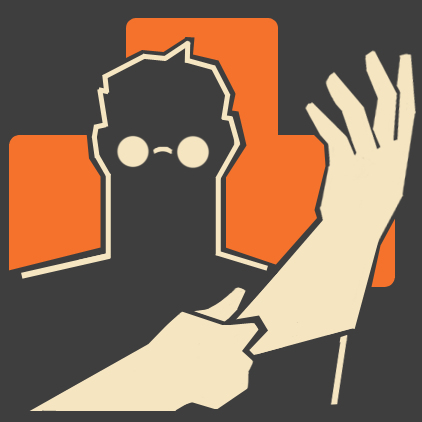A discussion on the proper display of health in video games
By DrRandle 16 Comments
For the health of it

Display your dismay
If there's one thing that's more aggravating than losing health, it's not knowing why. Setting up a central hud element that points to the direction of your damage, especially in a first person shooter, is key. Imagine how frustrating Left 4 Dead would be if it didn't tell you there was a zombie right behind you. Most games have figured this out, and it's pretty common, but every now and again someone drops the ball. The original Mass Effect comes to mind, where the flashes of red were barely visible, very broad, and quick to disappear.It's not just about clearly showing the direction, though. A player should be able to tell where the projectiles are coming from, if they're in a position to know. Borderlands does a wonderful job of trailing each bullet with a long, white streak that is easily visible and points your enemies out clearly. This allows you to take cover in the proper direction, while helping you to locate your enemy which makes for better gun-play. Unless you're dealing with purposefully hidden snipers, a visual cue like trailing bullets or distant muzzle flash is key to a less frustrating experience.
Health Utility Display
What's the proper way to display health on the user interface? The classic is a health bar. Ideally, it should always be displayed somewhere on the screen in a place that's easy to find and not in the way. Typically a corner is the ideal location, although games like Metroid Prime have managed to move it to a more central location, without getting in the way.However, some games have proven a little more esoteric about displaying health. The earlier Resident Evil and Silent Hill titles, for instance, require a player to pause a game, and then read the color of a snapshot of their current situation to figure out "about" how hurt they are. Having to pause the game to understand the situation is a bad idea, because your player is required to leave the moment and break their immersion.
The knowledge of a character's health should always be immediately available to the player. Not juts full health, or low health, but any health. Some games prefer to hide your health unless you're under immediate stress or even until you actually start taking damage. Theoretically, this is to minimize HUD elements, keeping a player more immersed, but it ends up being more frustrating and leading to a weaker design. A developer's best bet would be to follow in the examples of Dead Space and Borderlands: Integration through narrative. This may not work as well for more realistic games, but anyone willing to make a small stretch of the imagination can find plenty of HUD-less solutions. In a much less realistic, but incredibly useful move, the original Mario Bros. let you know whether or not you were allowed to take a hit by showing Mario as being twice as big, which also served as a unique game mechanic in physically traversing the two-dimensional world.
"Hero, your health is low"
Now that we've discussed the where and how a health bar should be displayed, let's talk about the tricky solution on what to do when that bar starts to sink as the danger sets in. The new super-popular trend is to have red start creeping in from the sides to alert you that you're in trouble, and I would like to dicuss why this is the worst idae to have found it's way into video games since the tailing mission. At best, the encroaching red display is mostly distant and relatively calm. At it's worst, this style of danger- warning covers almost everything on the screen and deafens the sound (save for a slow-pounding heartbeat for some reason). Thanks to this new visual and audio barrier it will be harder to find cover, harder to locate your enemies, and more difficult to defend yourself outside of firing blindly ahead. The end result? Frustration in the player. If the developer's intent is to aggrivate the player as a punishment for getting hit with a bullet, I suppose it's "Mission Accomplished," but if you're trying to display health issues during a fire fight, might I recommend something less game-ruining? Turning the entire world black and white is a popular variation to this mechanic. While not as damaging, it can still be a great hinderance to the player who is already struggling to survive.For the record, nobody violates this worst than Modern Warfare 2, who finds it necessary to splatter your screen with rasberry preserves every time you take a bullet to the shin. How it gets there, and why, I have no idea, but enjoy the blindness, I guess.
The alternative to this is an audio cue, which in the older days wasn't well implemented, either. I think everyone can relate to tearing the garden apart in Zelda to find one more heart that will end the insufferable beeping sound. While a completely different than your standard health mechanic, Yoshi's Island had a similar irritating quality: whenever you were hit by anything, Baby Mario would become suddeny enveloped in a bubble and would drift around screaming at the top of his lungs for you to rescue him before a timer hit 0 and you officially lost.
However, in this day and age, since regenerating health and shields are all the rage, a beeping or buzzing would serve a much better purpose. It needs to go away as soon as you're out of trouble (or at least behind cover). It's just as immediate, if not more so, without being as intrusive as the encroaching redness. Kirby games tend to do something similar, giving you a loud beep as soon as you enter low-health teritory, but leaving it to the player to remember that they were low afterwards.

How's your health?
Overall, I think the games that have tackled this matter best are Borderlands, Dead Space, Resident Evil 4, and Super Mario Bros. They're clear, concise, sometimes part of the actual fiction, and very intuitive.On the side of needing improvement, we have Mass Effect 2 (What's the point of a regenerating health bar and shields? Just have one long bar that regenerates. Also, displaying your health and the health of your teammates needs to be consistent and more clear), Modern Warfare 2 (getting shot in the knee does not splatter jelly all over my eyes, and it's unclear how much more damage I can take before death), and Pokemon (Sure it's clear, but in a game that isn't even action based, a constant beeping is ridiculous and irritating, especially when a healing item takes you out of the red).
So what do you think? Any other pros or cons to health readings you think should be mentioned? Maybe something you think I'm incorrect about? Perhaps you can explain to me the fascination with regenerating shields/health, which I personally believe most games implement in a more harmful manner that constantly stops the action. Also feel free to list games you think have performed well or poorly below.
Feel free to follow me on Twitter @docrandle.
